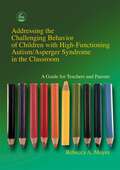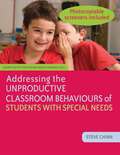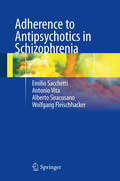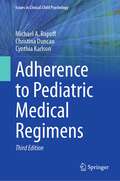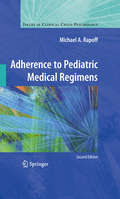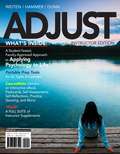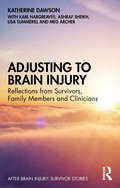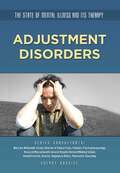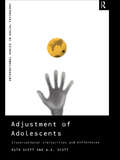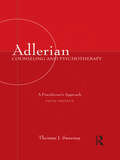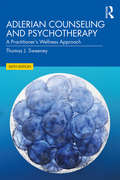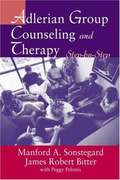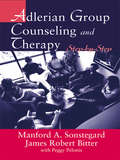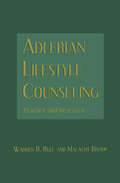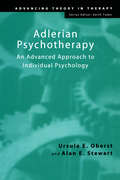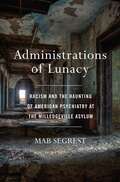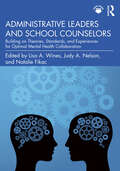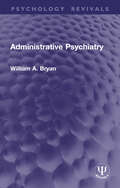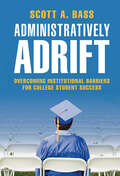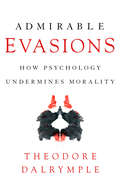- Table View
- List View
Addressing Violent Radicalisation and Extremism: A Restorative Justice & Psychosocial Approach
by Theo GavrielidesThis book adopts an interdisciplinary approach to confront one of the most urgent global challenges of our time violent radicalisation and extremism. It critically examines how restorative justice, positive criminology, and positive psychology intersect to address the behaviors and social conditions that foster extremism, offering a framework that reflects the complexities of our era. Grounded in a synthesis of philosophical inquiry, normative analysis, and empirical evidence from six international pilot projects conducted between 2017 and 2024, the volume navigates the shifting boundaries between punitive and preventive approaches. It explores the potential of community-based initiatives to foster understanding, empathy, and empowerment as means to reduce violence and promote reconciliation. Through a focus on the psychological and social roots of extremism, the book delves into the restorative capacity of justice systems to mend fractured communities and the role of positive psychological interventions in reshaping harmful behaviors. In doing so, it bridges theoretical advancements with actionable strategies for policymakers, practitioners, and researchers seeking alternatives to traditional punitive models. This collection reflects the depth and breadth of contemporary scholarship in counter-extremism, offering perspectives from established experts and emerging voices. It serves as a vital resource for those engaged in fields such as social work, human rights, conflict resolution, and criminology, contributing fresh insights and practical tools to prevent and mitigate radicalisation. &“This book offers a refreshing and holistic perspective on one of the most pressing global issues today violent extremism. By integrating restorative justice principles with a psychosocial approach, the book moves beyond punitive measures and focuses on healing, rehabilitation, and the reintegration of individuals into society. This book is a thought-provoking and important contribution to the discourse on counter-extremism&”.<span lang="EN-GB" style="font-size: 12.0pt; font-family: 'Times New Roman',serif; mso-fare
Addressing the Challenging Behavior of Children with High-Functioning Autism/Asperger Syndrome in the Classroom: A Guide for Teachers and Parents
by Rebecca MoyesHow do teachers and parents of children with autism address a child's social skills? And what do they do about problem behaviors? This book provides possible explanations for these behaviours, and a wealth of practical help for both teachers and parents to address them. Teachers learn how to create environmental supports and how to incorporate specific teaching strategies. Students with autism learn the new skills they might need, and ways of making their behavior more acceptable. This book is full of practical tips on how to tackle different kinds of challenging behaviors both in the classroom and outside it.
Addressing the Unproductive Classroom Behaviours of Students with Special Needs
by Steve Chinn*Shortlisted for the 2011 NASEN Award 'Book to Promote Professional Development'*Certain classroom behaviours can signify an underlying learning disability. This book will help you recognise potential indicators of Asperger Syndrome, dyslexia, dyspraxia, AD/HD, physical disabilities and speech and language disorders; explores the benefits of different interventions; and offers practical strategies for improving pupils' behaviours, social skills and self-esteem. This book contains:- A simple-to-use screener for initial identification of a pupil's specific learning disability- A practical and simple structure for monitoring classroom behaviours and creating an Individual Behaviour Plan- Tried-and-tested teacher strategies for common areas of concern, such as problems staying on task, inability to work on group tasks and failure to seek help when needed- Key educational theories to help teachers understand and influence classroom behaviours, and further develop classroom management skills for addressing the behaviours of special needs pupils. This practical, accessible book is an essential tool kit for special educational needs coordinators, learning support staff and teachers in both primary and secondary schools.
Adherence to Antipsychotics in Schizophrenia
by Emilio Sacchetti Antonio Vita Alberto Siracusano Wolfgang FleischhackerPoor adherence to therapy is one of the main obstacles to treatment effectiveness in schizophrenia. It is the main determinant of relapse, hospitalization, symptom persistence, and poor psychosocial functioning and outcome. Adherence to treatment is affected by various factors related to the disease characteristics, to the patient him- or herself, to the treatment, and to the therapeutic relationship. Some of these factors are modifiable, and both pharmacological and non-pharmacological strategies have been developed for this purpose. This book addresses the different aspects of adherence to treatment in schizophrenia and related disorders in a systematic but easy-to-use manual format. Chapters focus on a full range of issues, including pharmacological and non-pharmacological strategies to enhance adherence and continuity of care, relevant psychological factors, the importance of the patient-doctor relationship, and the need for an alliance with other care-givers. Adherence to Antipsychotics in Schizophrenia will be an invaluable asset for all who are involved in the care of patients with schizophrenia.
Adherence to Pediatric Medical Regimens (Issues in Clinical Child Psychology)
by Michael A. Rapoff Christina Duncan Cynthia KarlsonThe third edition of this book provides comprehensive coverage of pediatric medical adherence, including such important topics as the extent of nonadherence and medical consequences, predictors of adherence, theories about adherence and clinical applications, and assessment strategies for adherence and health outcomes. In addition, chapters describe strategies for improving adherence, review research studies on improving adherence, and address ways to improve research on adherence for children and adolescents with chronic diseases. The new edition also examines the developmental aspects of adherence assessment and intervention as well as cultural, ethical, and legal issues in adherence research and practice. Key areas of coverage include: Consequences of nonadherence and correlates of adherence. Developmental aspects related to assessing and improving pediatric medical adherence. Assessing pediatric disease and health status. Cultural, ethical, and legal issues related to pediatric medical adherence. Adherence to Pediatric Medical Regimens, Third Edition, is an essential reference for researchers, professors, and graduate students as well as clinicians, therapists, and other practitioners in developmental, clinical child and school psychology, child and adolescent psychiatry, pediatrics and pediatric psychology, social work, public health, health psychology, and all interrelated fields.
Adherence to Pediatric Medical Regimens (Issues in Clinical Child Psychology)
by Michael A. RapoffIt used to be called noncompliance, and the patients themselves referred to as difficult. But regardless of the terminology, children's reluctance or failure to commit to prescribed regimens reduces the effectiveness of treatment, often leading to additional care, higher costs, and serious, even deadly, complications. Reflecting a single, authoritative voice, the Second Edition of Adherence to Pediatric Medical Regimens analyzes in comprehensive clinical detail the factors that affect children's and teens' commitment to treatment - from developmental issues to the influence of parents, peers, and others in their orbit - and offers empirically sound guidelines for encouraging adherence. It cautions against viewing young clients as miniature grownups or scaling down adult data, advocating instead for a more nuanced understanding of the population and a collaborative relationship between practitioner and client. Critical areas of interest to clinicians and researchers in pediatrics are brought into clear focus as the book: Provides an overview of adherence rates to chronic and acute disease regimens and examines common adherence problems in children and adolescents. Details consequences of nonadherence and correlates of adherence. Critiques major adherence theories and their clinical implications. Discusses the range of adherence assessment measures. Reviews educational, behavioral and other strategies for improving adherence. Offers ways to translate research into pediatric medical adherence. This updated edition of Adherence to Pediatric Medical Regimens is an essential reference for anyone concerned with improving health outcomes in young people, especially clinicians, researchers, and graduate students in psychiatry as well as pediatric, clinical child, and health psychology.
Adicta a un gilipollas: Supera tu adicción emocional a una relación tóxica
by Lara FerreiroUn programa de desintoxicación radical en seis semanas para liberarte de tu adicción emocional.¿Crees que tal vez seas adicta a un hombre tóxico? ¿Acabas siempre enganchada al mismo perfil de gilipollas? ¿Repites patrones tóxicos en tus relaciones? ¿Quieres aprender a detectar y evitar esos comportamientos? ¿Te gustaría reforzar tu amor propio y construir una relación sana de pareja?Lara Ferreiro,psicólogade referenciaen España, ha formulado un método pionero que te ayudará a desengancharte de una relación tóxica. Este libro incluye:* un «yonquitest» para que conozcas tu grado de adicción emocional,* historiasde otras mujeres que pasaron por la misma situación que tú y la superaron, * los diez perfiles de adictas emocionales más comunes para que descubras tu rueda adicta,* el «top 10 de gilipollas» con los perfiles de hombres tóxicos más habituales,* un programa de desintoxicación radical de seis semanas para desengancharte de tu relación tóxica.A lo largo de estas páginas aprenderás a no permitir que nadie te maltrate, a valorarte, a quererte incondicionalmente, a sanar tus heridas emocionales y a sentirte digna de amor y merecimiento. Despierta a la mujer fuerte y empoderada que llevas dentro. Este libro es el primer paso hacia tu nueva vida.
Adjust: Applying Psychology to Life
by Wayne Weiten Dana S. Dunn Elizabeth Yost HammerCreated through a 'student-tested, faculty-approved' review process, ADJUST is an engaging and accessible solution to accommodate the diverse lifestyles of today's learners. ADJUST employs balanced psychological research coverage, engaging applications, and current examples to help readers understand themselves and the world.
Adjusting to Brain Injury: Reflections from Survivors, Family Members and Clinicians (After Brain Injury: Survivor Stories)
by Katherine Dawson Ashraf Sheikh Karl Hargreaves Meg Archer Lisa SummerillThis important book in the After Brain Injury: Survivor Stories Series tells the story of four people who suffered acquired brain injuries: Karl Hargreaves and Ashraf Sheikh as a result of road traffic accidents, Lisa Summerill because of a stroke and Meg Archer as a result of meningitis. Each person tells their story in their own words, describing what happened to them, how they dealt with it and how they experienced the recovery process. The cases represent very different types of people and severity of injury but are alike in providing raw accounts of the challenges faced whilst also highlighting their resilience and determination to carve out new lives. Alongside these inspirational stories are contributions by friends and family, as well as several members of the interdisciplinary rehabilitation team to give a broader view of the whole process of recovery. By combining expert commentary with real life experiences, this book points towards sources of support, normalises the experience and provides a context for understanding the challenges and successes in each case. This book provides support, understanding and hope for patients who have suffered a brain injury. It is valuable reading for any professional involved in neurorehabilitation and students of clinical neuropsychology.
Adjustment Disorders (The State of Mental Illness and Its Ther #19)
by Sherry BonniceWe all have to deal with stress sometimes. Learning to balance our many responsibilities, adjust to new situations, and handle multiple stresses is part of life. But does this mean that you should feel stressed all the time? What if you always feel overwhelmed? What if you simply can't adjust to a new challenge or situation? When the normal challenges of life cause such extreme emotional turmoil that a person cannot adapt and react appropriately, he may be suffering from an adjustment disorder. Those who suffer from adjustment disorders find it particularly difficult to adapt and function in their daily environments. Perhaps they are dealing with a loss or change in life, such as divorce, moving, a new baby, or an end to a relationship. Perhaps they overreact to minor stresses or have anxiety, depression, or conduct disorders that interrupt their normal life functions. When their inability to cope becomes a mental illness, people need help from medical professionals to gain control of their lives again. In Adjustment Disorders, you will learn about the antidepressants and anti-anxiety drugs available to treat adjustment disorders. Along the way, you will read about the history of psychiatric drugs, how they work, and current treatment methods. You will also read valuable information about what to expect when taking psychiatric drugs, as well as some of the most prevalent alternatives to drug treatment. Sharing the experiences of young people as they cope with divorce, disappointment, moving, depression, and anxiety may help you understand how such changes can affect your life as well...and where to turn if your reactions to these changes get out of control.
Adjustment of Adolescents: Cross-Cultural Similarities and Differences (International Series in Social Psychology)
by William Scott W. A. ScottThis book will make fascinating reading for anyone involved in the study of adolescence, or working with adolescents. The authors explore the transitions of school, family and personality in the contexts of family, friends and wider social factors. This exploration is based on original research carried out in Canberra, Winnipeg, Phoenix, Berlin, Hong Kong, Osaka and Taipei. The authors also provide valuable insights into the methodologies of cross-cultural study. The perspectives of this book make it an ideal resource for undergraduates and masters students undertaking a cross-cultural study, which is becoming a mandatory part of many degree courses.
Adjustment to Severe Physical Disability: A Metamorphosis
by Charlene Deloach Bobby G. Greer<p><i>Adjustment to Severe Physical Disability: A Metamorphosis</i>, then, is designed for professionals-in-training, practicing professionals, and parents or families of disabled persons. <p>The book deals with (1) the societal misconceptions that impede the physical, psychological, and social adjustment of disabled persons; (2) the effects these misconceptions have on the attitudes and effectiveness of those who work with disabled persons; and (3) existing services, laws, environmental changes, and technological advances that affect both the efforts of professionals and the lives of disabled persons. In keeping with the goals of this book, the content ranges from hard science to advocacy, from objective data to personal experiences. Case illustrations are designed to stimulate discussion and self-exploration, as well as to illuminate the factual basis for author opinions with no printed sources. Ideally, these illustrations will serve a heuristic function, leading students to conduct needed research into the psychosocial aspects of disability. </p>
Adlerian Counseling and Psychotherapy: A Practitioner's Approach, Fifth Edition
by Thomas J. SweeneyAdlerian Counseling and Psychotherapy, now in its fifth edition, remains a classic text for students and an essential resource for practitioner's of all levels of experience. Reviewers have consistently lauded the book in previous editions for its clarity, concise focus, and use of many practical applications. It explains and illustrates individual, group, and couples work with children, adolescents, and adults of all ages. It highlights Adler's and Dreikurs's unique contributions to child guidance, lifestyle assessment and early recollections, and why it has been rated the most multicultural appropriate theory among counseling approaches. The fifth edition presents a fresh organization and an even clearer structure. A new emphasis is placed on the distinction between counseling and psychotherapy, as practiced from the Adlerian perspective. Additional chapter activities and review questions are added throughout the text, and all previous material is updated and refreshed.
Adlerian Counseling and Psychotherapy: A Practitioner's Wellness Approach
by Thomas J. SweeneyAdlerian Counseling and Psychotherapy, now in its sixth edition, places a fresh emphasis on wellness both in concept and in practice. Written with the practitioner in mind, this text provides a definitive overview of the theory and practice of individual psychology based on the work of both Alfred Adler and Rudolf Dreikurs. The sixth edition retains the clarity, focus, and practicality of the previous editions and incorporates research, methods, and techniques to illustrate the usefulness of the Adlerian approach with children, adolescents, and adults of all ages in settings with individuals, groups, and couples. Parent education, career counseling, lifestyle assessment and counseling, and clinical diagnosis and psychotherapy are all discussed, as are applications for working with clients of different cultural and ethnic backgrounds and gender orientations. Neuroscience concepts and methods are described in case examples that illustrate their effectiveness across the lifespan. Readers will also find clinical examples from lifestyle assessment and family counseling meetings, as well as tables and figures that augment the activities and review questions included with each chapter.
Adlerian Group Counseling And Therapy: Step-by-step
by James Robert Bitter Manford A. Sonstegard Peggy Pelonis<P>Adlerian Group Counseling and Therapy: Step-by-Step represents a distillation of some of the most significant ideas pertaining to the group work of Alfred Adler and Rudolf Dreikurs. <P>Drs. Manford Sonstegard and James Bitter illustrate the development of a group from its formation to its final stage, giving readers a clear picture of what is important to accomplish at each stage of the group. <P>This book also addresses many practical dimensions of the Adlerian group process, including: forming a group relationship; creating a democratic and accepting climate; conducting psychological assessments; increasing the awareness and insight of group members; translating group insight into action; methods of re-education through encouragement; and building on personal strengths discovered within the group experience.
Adlerian Group Counseling and Therapy: Step-by-Step
by James Robert Bitter Manford A. Sonstegard Peggy PelonisAdlerian Group Counseling and Therapy: Step-by-Step represents a distillation of some of the most significant ideas pertaining to the group work of Alfred Adler and Rudolf Dreikurs. Drs. Manford Sonstegard and James Bitter illustrate the development of a group from its formation to its final stage, giving readers a clear picture of what is important to accomplish at each stage of the group. This book also addresses many practical dimensions of the Adlerian group process, including: forming a group relationship; creating a democratic and accepting climate; conducting psychological assessments; increasing the awareness and insight of group members; translating group insight into action; methods of re-education through encouragement; and building on personal strengths discovered within the group experience.
Adlerian Lifestyle Counseling: Practice and Research
by Malachy Bishop Warren R. RuleA rare balance of both practical application and empirical research investigation, Adlerian Lifestyle Counseling provides mental health practitioners with an invaluable resource on the theories of counseling pioneer Alfred Adler. Warren R. Rule and Malachy Bishop, both reputed authorities on rehabilitation counseling and Adlerian theory, present useful practitioner consideration and applications, preparing the reader for a wide variety of counseling situations. Research studies also included in this volume - on topics scanning career choice, parental behavior, personal characteristics, and more - ground these practices in a basic theoretical framework. Adlerian theory is a popular and powerful approach that respects the uniqueness and creative potential of the individual. This comprehensive collection on the topic is a significant addition to the counseling research canon.
Adlerian Psychotherapy: An Advanced Approach to Individual Psychology (Advancing Theory in Therapy)
by Ursula E. Oberst Alan E. StewartAdlerian Psychotherapy gives an account of Adlerian therapy and counselling from its origins to the present day, and proposes an advanced version of the theory. The main principles and concepts of Adler's thinking are re-examined from a contemporary perspective, placing them in the context of other contemporary approaches. Adler's techniques are described then applied to an understanding of what an Adlerian approach to family life would look like, using clinical examples throughout. The authors analyse the possible contribution of Adlerian theory in the context of the challenges of postmodern thought and postmodern society. It will be invaluable to professionals, practitioners and students of counselling and psychotherapy.
Administrations Of Lunacy: Racism And The Haunting Of American Psychiatry At The Milledgeville Asylum
by Mab SegrestA scathing and original look at the racist origins of psychiatry, through the story of the largest mental institution in the world Today, 90 percent of psychiatric beds are located in jails and prisons across the United States, institutions that confine disproportionate numbers of African Americans. After more than a decade of research, the celebrated scholar and activist Mab Segrest locates the deep historical roots of this startling fact, turning her sights on a long-forgotten cauldron of racial ideology: the state mental asylum system in which psychiatry was born and whose influences extend into our troubled present. In December 1841, the Georgia State Lunatic, Idiot, and Epileptic Asylum was founded. A hundred years later, it had become the largest insane asylum in the world with over ten thousand patients. Administrations of Lunacy tells the story of this iconic and infamous southern institution, a history that was all but erased from popular memory and within the psychiatric profession. Through riveting accounts of historical characters, Segrest reveals how modern psychiatric practice was forged in the traumas of slavery, the Civil War, Reconstruction, and Jim Crow. Deftly connecting this history to the modern era, Segrest then shows how a single asylum helped set the stage for the eugenics theories of the twentieth century and the persistent racial ideologies of our own times. She also traces the connections to today’s dissident psychiatric practices that offer sanity and create justice. A landmark of scholarship, Administrations of Lunacy restores a vital thread between past and present, revealing the tangled racial roots of psychiatry in America.
Administrative Leaders and School Counselors: Building on Theories, Standards, and Experiences for Optimal Mental Health Collaboration
by Lisa A. Wines Judy A. Nelson Natalie FikacThis practice-based text offers a roadmap to optimal collaboration for all school leaders – including counselors, superintendents, principals, and university faculty – to provide the best mental health outcomes for students. Administrative Leaders and School Counselors is a timely publication that creatively and cohesively authenticates the relationship between administrative leaders and school counselors. In order to systemically promote mental health consciousness and considerations for school counselors as practitioners and in training, collaboration among school leaders is essential for comprehensive school counseling programs, practices, funding, partnerships, and services designed for students. The first to feature perspectives from a diverse set of leadership positions in schools, the book provides individuals with exposure to educational leadership models and decisions that impact the roles of school counselors. The book will appeal to faculty who are teaching and training those who are or will ultimately be working as professional school counselors, counseling psychologists, or educational leaders such as principals, directors, department chairs, and superintendents.
Administrative Psychiatry (Psychology Revivals)
by William A. BryanOriginally published in 1937, Administrative Psychiatry was the first book to present theory and practice in a hospital for psychiatric patients. Every detail of the organization and direction of a psychiatric hospital is described in this volume. Everything advocated in this volume had passed the test of actual trial, the principles set forth having been in continuous operation over a period of years before the book was written. A pioneering text at the time, today it can be read in its historical context.This book is a re-issue originally published in 1937. The language used is a reflection of its era and no offence is meant by the Publishers to any reader by this re-publication.
Administratively Adrift: Overcoming Institutional Barriers for College Student Success
by Scott A. BassThe multiple crises of 2020–21 have presented both challenges and opportunities for change in four-year residential colleges and universities. Evidence indicates that the historic structure of administrative and student services is increasingly mismatched to the needs of a diverse and stressed student body born in a digital age. Inspired by his leadership in a university-wide initiative that focused on how students' interactions with both academic and professional staff affect their success and well-being, Scott A. Bass presents fresh insights on the inner workings of traditional nonprofit four-year degree residential institutions. The book describes the influences of history, tradition, and internal and external pressures on the American university, highlighting its evolution to its staid and fragmented structure; it distills voices of students, faculty, and staff; and it explores how successful organizations outside of higher education deliver services, with potential applicability for the academy's ability to meet students where they are.
Admirable Evasions
by Theodore DalrympleIn Admirable Evasions, Theodore Dalrymple explains why human self-understanding has not been bettered by the false promises of the different schools of psychological thought. Most psychological explanations of human behavior are not only ludicrously inadequate oversimplifications, argues Dalrymple, they are socially harmful in that they allow those who believe in them to evade personal responsibility for their actions and to put the blame on a multitude of scapegoats: on their childhood, their genes, their neurochemistry, even on evolutionary pressures.Dalrymple reveals how the fashionable schools of psychoanalysis, behaviorism, modern neuroscience, and evolutionary psychology all prevent the kind of honest self-examination that is necessary to the formation of human character. Instead, they promote self-obsession without self-examination, and the gross overuse of medicines that affect the mind.Admirable Evasions also considers metaphysical objections to the assumptions of psychology, and suggests that literature is a far more illuminating window into the human condition than psychology could ever hope to be.
Adolescence
by John SantrockAs a master teacher, John Santrock connects current research with real-world application, helping students see how developmental psychology plays a role in their own lives and future careers. Through an integrated learning goals system, this comprehensive approach to adolescent development helps students gain the insight they need to study smarter, stay focused, and improve performance.
Adolescence
by John W. SantrockAs a master teacher, John Santrock connects current research with real-world application, helping students see how developmental psychology plays a role in their own lives and future careers. Through an integrated learning goals system, this comprehensive approach to adolescent development helps students gain the insight they need to study smarter, stay focused, and improve performance.

